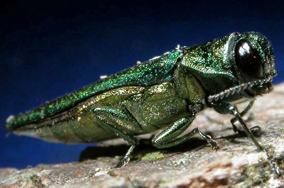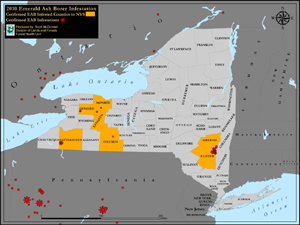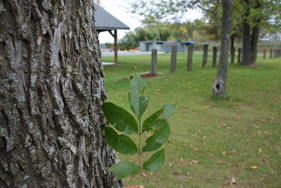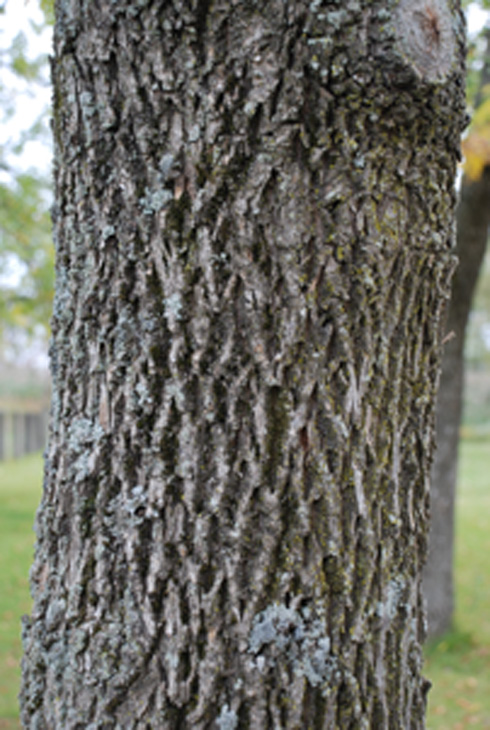Emerald Ash Borer Information for the City of Kingston

Image courtesy of www.nysis.info
Background
The Emerald Ash Borer (EAB) is an invasive insect recently discovered in several regions of NY. This insect is known to kill all types of Ash trees, regardless of size and vigor and spreads through flight and by transportation in firewood, logs, and nursery stock. The impact of EAB on communities is profound and Ash mortality is almost 100%. The Borer was first identified in Western New York in 2009 and was discovered in Ulster County during the Summer of 2010.
Information about Ash trees
NYS has over 900 million ash trees, comprising 7% of all the trees in the state. Many are located on your streets, in your parks and yards, and in your forests. Once effected by EAB, most Ash trees die within five years. Once Ash trees die, they quickly rot and break apart. Trees will have to be removed as they become public safety issues. This can be a significant expense depending on the number and size of hazardous Ash trees in the community.
Streets, parks and yards will be devoid of the shade trees they once had. Loss of shade trees on streets, yards and parks will negatively impact winter and summer energy consumption, water use, property values, aesthetics, and community morale.
Has the Emerald Ash Borer been found in Kingston?
Yes, unfortunately, entomologists from the United States Department of Agriculture, Agricultural Research Station in Ithaca, New York identified infested trees on city land at Kingston Point Park in mid-september 2010. This is the first known location of the insect within the City of Kingston, however, we believe the EAB is most likely in other locations on private land in Kingston and adjacent communities.

Known locations of EAB in NYS
(Red indicates confirmed EAB sighting, Yellow indicates County's impacted)
What are we doing about it?
The City of Kingston is working collaboratively with the New York State Department of Environmental Conservation, Ulster County Cornell Cooperative Extension, USDA's Agricultural Research Station, and other local, state and federal agencies in order to prepare and manage this crisis.
The City of Kingston is also working with the Kingston's volunteer Tree Commission and Conservation Advisory Council. The City will be working with the public in order to gather information about Ash trees in the community through a web based Ash tree reporting survey and on the ground street tree surveys. The City will also be preparing a New York State Emerald Ash Borer Community Preparedness Plan during the winter of 2010-2011 in order to be prepared for the spread of the Emerald Ash Borer in our Community.
Kingston's first step is to identify Ash trees in our Community. Unfortunately, the City of Kingston does not have a complete street tree inventory and will rely on volunteers to indentify Ash trees located along the city streets, on parkland and other areas. Focus will be on trees that will impact infrastructure such as roads, sidewalks and powerlines, while also surveying for trees that can pose hazards to Kingstonians.
How can YOU help?
Help us identify Ash trees in your neighborhood. Spend a few moments learning what an Ash tree looks like, then survey your street. If you have Ash trees, please fill out our online survey. A few moments of your time will allow Kingston to better plan for the future.
http://www.surveymonkey.com/s/Kingstonashtrees
Another important way to help. DONT MOVE FIREWOOD. The movement of firewood is how EAB arrive in Ulster County and we want to SLOW the Spread. So please do your part and DONT MOVE FIREWOOD. Visit https://dec.ny.gov/ for more information about firewood regulations and quarantines.
What do Ash Tree's Look Like?

White Ash, One of our most common ash trees

The Bark of an Ash Tree has characteristic groves and patterns
For more information about EAB and distinguishing Ash trees, visit www.emeraldashborer.info or click on these helpful tools!
Ash Tree Identification
Resources